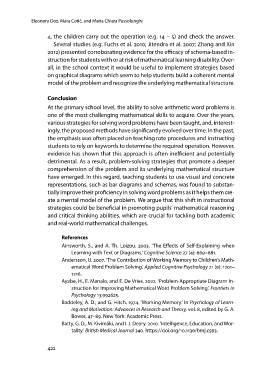Page 422 - Istenič Andreja, Gačnik Mateja, Horvat Barbara, Kukanja Gabrijelčič Mojca, Kiswarday Vanja Riccarda, Lebeničnik Maja, Mezgec Maja, Volk Marina. Ur. 2023. Vzgoja in izobraževanje med preteklostjo in prihodnostjo. Koper: Založba Univerze na Primorskem
P. 422
onora Doz, Mara Cotič, and Maria Chiara Passolunghi
4, the children carry out the operation (e.g. 14 – 5) and check the answer.
Several studies (e.g. Fuchs et al. 2010; Jitendra et al. 2007; Zhang and Xin
2012) presented corroborating evidence for the efficacy of schema-based in-
struction for students with or at risk of mathematical learning disability. Over-
all, in the school context it would be useful to implement strategies based
on graphical diagrams which seem to help students build a coherent mental
model of the problem and recognize the underlying mathematical structure.
Conclusion
At the primary school level, the ability to solve arithmetic word problems is
one of the most challenging mathematical skills to acquire. Over the years,
various strategies for solving word problems have been taught, and, interest-
ingly, the proposed methods have significantly evolved over time. In the past,
the emphasis was often placed on teaching rote procedures and instructing
students to rely on keywords to determine the required operation. However,
evidence has shown that this approach is often inefficient and potentially
detrimental. As a result, problem-solving strategies that promote a deeper
comprehension of the problem and its underlying mathematical structure
have emerged. In this regard, teaching students to use visual and concrete
representations, such as bar diagrams and schemas, was found to substan-
tially improve their proficiency in solving word problems as it helps them cre-
ate a mental model of the problem. We argue that this shift in instructional
strategies could be beneficial in promoting pupils’ mathematical reasoning
and critical thinking abilities, which are crucial for tackling both academic
and real-world mathematical challenges.
References
Ainsworth, S., and A. Th. Loizou. 2003. ‘The Effects of Self-Explaining when
Learning with Text or Diagrams.’ Cognitive Science 27 (4): 669–681.
Andersson, U. 2007. ‘The Contribution of Working Memory to Children’s Math-
ematical Word Problem Solving.’ Applied Cognitive Psychology 21 (9): 1201–
1216.
Ayabe, H., E. Manalo, and E. De Vries. 2022. ‘Problem-Appropriate Diagram In-
struction for Improving Mathematical Word Problem Solving.’ Frontiers in
Psychology 13:992625.
Baddeley, A. D., and G. Hitch. 1974. ‘Working Memory.’ In Psychology of Learn-
ing and Motivation: Advances in Research and Theory, vol. 8, edited by G. A.
Bower, 47–89. New York: Academic Press.
Batty, G. D., M. Kivimäki, and I. J. Deary. 2010. ‘Intelligence, Education, and Mor-
tality.’ British Medical Journal 340. https://doi.org/10.1136/bmj.c563.
422
4, the children carry out the operation (e.g. 14 – 5) and check the answer.
Several studies (e.g. Fuchs et al. 2010; Jitendra et al. 2007; Zhang and Xin
2012) presented corroborating evidence for the efficacy of schema-based in-
struction for students with or at risk of mathematical learning disability. Over-
all, in the school context it would be useful to implement strategies based
on graphical diagrams which seem to help students build a coherent mental
model of the problem and recognize the underlying mathematical structure.
Conclusion
At the primary school level, the ability to solve arithmetic word problems is
one of the most challenging mathematical skills to acquire. Over the years,
various strategies for solving word problems have been taught, and, interest-
ingly, the proposed methods have significantly evolved over time. In the past,
the emphasis was often placed on teaching rote procedures and instructing
students to rely on keywords to determine the required operation. However,
evidence has shown that this approach is often inefficient and potentially
detrimental. As a result, problem-solving strategies that promote a deeper
comprehension of the problem and its underlying mathematical structure
have emerged. In this regard, teaching students to use visual and concrete
representations, such as bar diagrams and schemas, was found to substan-
tially improve their proficiency in solving word problems as it helps them cre-
ate a mental model of the problem. We argue that this shift in instructional
strategies could be beneficial in promoting pupils’ mathematical reasoning
and critical thinking abilities, which are crucial for tackling both academic
and real-world mathematical challenges.
References
Ainsworth, S., and A. Th. Loizou. 2003. ‘The Effects of Self-Explaining when
Learning with Text or Diagrams.’ Cognitive Science 27 (4): 669–681.
Andersson, U. 2007. ‘The Contribution of Working Memory to Children’s Math-
ematical Word Problem Solving.’ Applied Cognitive Psychology 21 (9): 1201–
1216.
Ayabe, H., E. Manalo, and E. De Vries. 2022. ‘Problem-Appropriate Diagram In-
struction for Improving Mathematical Word Problem Solving.’ Frontiers in
Psychology 13:992625.
Baddeley, A. D., and G. Hitch. 1974. ‘Working Memory.’ In Psychology of Learn-
ing and Motivation: Advances in Research and Theory, vol. 8, edited by G. A.
Bower, 47–89. New York: Academic Press.
Batty, G. D., M. Kivimäki, and I. J. Deary. 2010. ‘Intelligence, Education, and Mor-
tality.’ British Medical Journal 340. https://doi.org/10.1136/bmj.c563.
422


